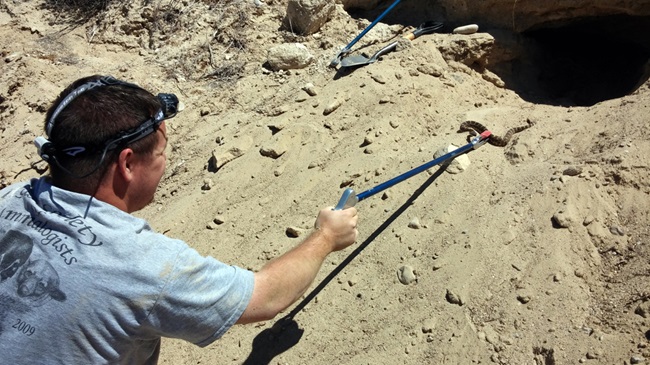April 09, 2019

Sigma Xi member and grant recipient Jason Strickland studies Mojave rattlesnakes in the southwestern United States and central Mexico as a postdoctoral researcher at Clemson University. (Image courtesy of Gregory Territo.)
Grant awarded: $1,000 in fall 2015
Education level at the time of the grant: doctoral student
How were the funds used: to pay for travel to field locations to find Mojave rattlesnakes and for gene-sequencing costs for data generation
Project goal: Mojave rattlesnakes are known to have neurotoxic venom that can paralyze the nervous system of prey. Some snakebite documentation, however, showed patients displaying symptoms of a second venom type—hemorrhagic—that acts by destroying tissue in the body. Strickland and his colleagues led a study to discover where the different venom types occur. This project involved a research collaboration between principal investigators and students at five laboratories across the United States and Mexico. Through social media and networking, Strickland and colleagues also assembled almost 100 citizen scientists. In total, the project collected 216 Mojave rattlesnakes in California, Arizona, New Mexico, Texas, and Mexico with permission granted by local permits and approval by an animal care and use committee.
Project results: Mojave rattlesnakes with hemorrhagic venom were more common throughout the snake’s geographic distribution than researchers previously thought, and the data suggested that some snakes were hybrids, with both types of venom. The results were published on December 4, 2018, in a Scientific Reports article titled “Evidence for divergent patterns of local selection driving venom variation in Mojave Rattlesnakes (Crotalus scutulatus).”
“Our study documents the extent of venom variation for the first time and demonstrates that local adaptation can occur at fine scales even when gene flow is high,” Strickland said. “Our work will inform research focused on the biochemical properties and medical implications of venom. Additionally, Mojave rattlesnakes will be a great system to help us understand the interplay between evolutionary forces and ecological processes.”
Knowing where the different venoms occur can help snakebite victims receive the best treatment and could inform antivenom development. This study also brings up questions related to the snake’s population genetics and evolution, such as what is driving the different venom types to occur.
Where is he now? Strickland was inducted into Sigma Xi in 2016 and earned his doctorate in conservation biology in 2018 from the University of Central Florida. He completed and published the study as a postdoctoral researcher at Clemson University. He can be reached for research inquiries at jlstrck@clemson.edu.
Reporting by Hannah Halusker of Clemson University and Heather Thorstensen of Sigma Xi.